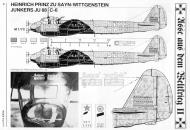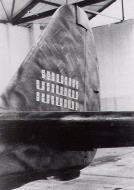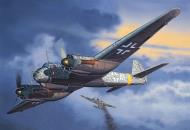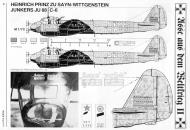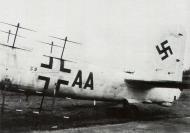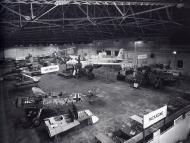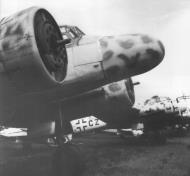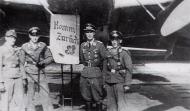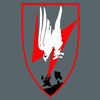 Geschwader Stab Nachtjagdgeschwader 5 - Geschwader Stab NJG5
Geschwader Stab Nachtjagdgeschwader 5 - Geschwader Stab NJG5
Photo 01: Oberfeldwebel Paul Mahle, an armourer attached to II./NJG5 at Parchim, worked closely with Rudolf Schoenert and built his own working prototype of 'Schrage Musik', which was soon fitted to all of the Gruppe's aircraft.
Photo 01: In order to bolster the makeshift night fighter units operating in Russia, IV/NJG5, under the command of Hauptmann Heinrich Prinz zu Sayn-Wittgenstein, was deployed to Insterburg in East Prussia on several occasions during 1943. Wittgenstein accumulated 33 victories against the Soviets.
Photo 01: In order to bolster the makeshift night fighter units operating in Russia, IV/NJG5, under the command of Hauptmann Heinrich Prinz zu Sayn-Wittgenstein, was deployed to Insterburg in East Prussia on several occasions during 1943. Wittgenstein accumulated 33 victories against the Soviets.
Photo 01: At the end of July 1943, IV/NJG5 was redesignated I./NJG100 and Hptm. Wittgenstein was transferred back to the West. He was succeeded by Hptm. Rudolf Schoenert, shown here, who finished the war as a holder of the Oak Leaves to the Knight's Cross and with a total of 64 victories.
Photo 02: After five years in the Merchant Navy, Rudolf Schoenert began flight training in 1933 and went on to fly commercial aircraft for Lufthansa, He was commissioned as a Leutnant in the Luftwaffe's Reserve in 1938 and, in June 1941, he joined 4,/NJG1 stationed at Bergen in northern Holland. He gained his first victories as a night fighter on 9 July 1941 and by 25 July 1942, at which time his total stood at 22, he was awarded the Knight's Cross, He is universally recognised as the driving force behind the introduction of upward-firing armaments in night fighter aircraft, the first prototype of which he introduced into his own Do-17 in 1942.This weapons system, which remained a complete mystery to all but a select few within Bomber Command, was codenamed 'Schrage Musik'.
Photo 01: The rear fuselage of a Junkers Ju 88G-6, WNr. 620788, with an unusual SN-2 aerial configuration. The aerials were mounted in this fashion in an experiment to determine whether the SN-2 would be less sensitive to 'Window' jamming, more effective in detecting high-flying bombers, and more efficient in detecting Mosquitoes approaching from behind and below. This particular aircraft, coded C9+AA, was assigned to Eichenlaubtrager Major Rudolf Schonert, the Kommodore of NJG5 at Lubeck-Blankensee, who is thought to have flown the machine with this installation only once. On that occasion, during a sortie east of the Elbe on 27 April 1945, an electrical fault rendered the radar unserviceable and the Ju 88 was shot down by a Mosquito. Schonert survived and was rescued by German troops. He died in Canada in 1985.
Profile 00: Junkers Ju 88G-6 flown by Major Hans Leickhardt, Kommandeur of II./NJG5, Stubendorf, late 1944. The camouflage on this machine provides a good example of how the overall grey 75 on the uppersurfaces, which was found unsuitable for night operations, was lightened with an overs pray of 76 but in such a manner that irregular patches of the original 75 remained as a result of the method of overspraying. As the accompanying photograph shows what is thought to be part of a Kommandeur's double chevron just ahead of the letters 'AC' on the fuselage, this profile has been completed accordingly.
Painting A0: Junkers Ju 88G-6 flown by Major Hans Leickhardt, Kommandeur of II./NJG5, Stubendorf, late 1944. The camouflage on this machine provides a good example of how the overall grey 75 on the uppersurfaces, which was found unsuitable for night operations, was lightened with an overs pray of 76 but in such a manner that irregular patches of the original 75 remained as a result of the method of overspraying.
Photo 01: This Junkers Ju 88G-6 was one of the few aircraft equipped with FuG-220 SN-2 radar with a 'Morgenstern' aerial. In this instance, the aerial has been left uncovered, but it was sometimes faired over within a long, tapered housing. It is thought that this particular machine was photographed in late 1944, at which time the operational code C9+AC on the fuselage side would indicate that it was flown by Major Hans Leickhardt who, from 3 May 1944 to 6 March 1945 was the Kommandeur of II./NJG5. Note the light area around the 'C' in the fuselage code and what is believed to be the corner of a Kommandeur's double chevron just visible behind the trailing edge of the starboard wing. Hans Leickhardtshot down 30 enemy aircraft all at night.
Photo 01: This Junkers Ju 88G-1, WNr. 714084, was photographed at St. Dizier in France in September 1944 and had belonged to I./NJG5. Note the differences in the finish between the fuselage and tailplane and that the 76 on the wings has been applied over the 75 in broad swathes. The operational code on this machine was (C9+OH).
Photo 01: An unusual feature of this Junkers Ju 88G-6 of 7./NJG5 which landed at Dübendorf on 30 April 1945 was the particularly dark uppersurface camouflage and the light color of the swastika and unit code. It is believed that the original factory finish was 75 on the uppersurfaces and 76 on the undersurfaces, although the uppersurfaces were later modified with what was described in a Swiss report on the aircraft as moss green with dense olive mottles, almost certainly 82 and 81 respectively. Note that all markings are either in white or possibly RLM 77.
Photo 01: This tail unit with 29 victory bars is reported to have belonged to the Ju 88 C-6 flown by Hptm. Heinrich Prinz zu Sayn-Wittgenstein, the Kommandeur of IV/NJG5, probably when based at Insterburg in East Prussia in Mayor June 1943.There are many inconstancies between the victory bars shown and Sayn-Wittgenstein's known confirmed victories. For example, although the bars in the bottom row including the linked bars which represent multiple kills correspond precisely with Sayn Wittgenstein's kills in July 1942, the rest cannot be reconciled with his subsequent claims. Moreover, on the night of 24/25 June 1943, he claimed four kills which raised his total from 28 to 32, but why only one of those victories should be shown, bringing the total to 29 bars, is again not known.The grey camouflage on this aircraft, a Ju 88 C-6 code C9+AE, would appear to consist of 74 mottles over 75.
Profile 00: Pilot - CO of IV./NJG5 Hauptmann Heinrich Alexander zu Sayn-Wittgenstein. Kursk area, Summer 1943. Heinrich Alexander zu Sayn-Wittgenstein was promoted to Major and is credited with 83 victories but KIA on 22 Jan 1944 in Luftkampf. 320ff (150 as Kampfflieger). He servered with the following units KG 51, NJG2, NJG5, NJG1, NJG3.
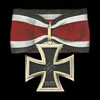
Asisbiz database list of 12 aerial victories for ace Hans Robert Leickhardt
| Date | Pilot Name | Unit | Enemy A/C Type | Location | Height | Time |
|---|---|---|---|---|---|---|
| 08-Apr-41 | Hans Leickhardt | 2.NJG3 | Whitley | Papenburg | 7600m | 00.29 |
| 08-Apr-41 | Hans Leickhardt | 2./NJG3 | Whitley | Papenburg | 00.29 | |
| 26-Jun-43 | Hans Leickhardt | 11./NJG1 | Lancaster | FM 73 (Kampen) | 4000m | 01.06 |
| 22-Oct-43 | Hans Leickhardt | 2./NJG5 | 4-mot. Flzg. | 30-40km N Kassel | 6000m | 21.18 |
| 03-Jan-44 | Hans Leickhardt | 2.NJG5 | Lancaster | 02.40 | ||
| 04-Jan-44 | Hans Leickhardt | 2./NJG5 | B-17 Fortress | |||
| 11-Jan-44 | Hans Leickhardt | 2./NJG5 | B-17 Fortress | Quakenbruck-Meppen (assessed) | 12.40E | |
| 21-Jan-44 | Hans Leickhardt | 2.NJG5 | Halifax | 3000m | 22.13 | |
| 29-Jan-44 | Hans Leickhardt | 2.NJG5 | Lancaster | 03.44 | ||
| 30-Jan-44 | Hans Leickhardt | 2.NJG5 | Lancaster | 20.23 | ||
| 20-Feb-44 | Hans Leickhardt | 2./NJG5 | 4-mot. Flgz. | FB (NE Gifhorn) | 5800m | 02.57 |
| 31-Mar-44 | Hans Leickhardt | 2./NJG5 | Halifax | NE Frankfurt/Main | 4600m | 00.53 |
| 13-Feb-45 | Hans Leickhardt | Stab II./NJG5 | Lancaster | |||
| 13-Feb-45 | Hans Leickhardt | Stab II./NJG5 | Lancaster | |||
| 06-Mar-45 | Hans Leickhardt | Stab II./NJG5 | 4-mot. Flzg. |

Asisbiz database list of 66 aerial victories for ace Rudolf Schoenert
| Date | Pilot Name | Unit | Enemy A/C Type | Height | Time | Location |
|---|---|---|---|---|---|---|
| Wednesday, July 09, 1941 | Rudolf Schoenert | 4./NJG1 | Whitley | 03:40 | ||
| Wednesday, July 09, 1941 | Rudolf Schoenert | 4./NJG1 | Whitley | 02:51 | ||
| Thursday, July 17, 1941 | Rudolf Schoenert | 4./NJG1 | Wellington | 4000m | 00:50 | 53/27/2 5km W Lemmer |
| Monday, August 04, 1941 | Rudolf Schoenert | 4.NJG1 | Wellington | 4700m | 00:14 | 53/19/2/7 Zuidersee (SW Staveren) |
| Tuesday, September 02, 1941 | Rudolf Schoenert | 4./NJG1 | Unident: | 4400m | 23:34 | 15km N Wangerooge |
| Friday, October 31, 1941 | Rudolf Schoenert | 4./NJG1 | Halifax | 22:05 | ||
| Friday, October 31, 1941 | Rudolf Schoenert | 4./NJG1 | Halifax | 21:37 | ||
| Sunday, November 02, 1941 | Rudolf Schoenert | Stab II./NJG2 | Hampden | |||
| Thursday, November 06, 1941 | Rudolf Schoenert | Stab II./NJG2 | Hampden | |||
| Sunday, November 30, 1941 | Rudolf Schoenert | Stab II./NJG2 | Whitley | |||
| Sunday, November 30, 1941 | Rudolf Schoenert | 5./NJG2 | Whitley | 3600m | 20:52 | Georgensheid |
| Saturday, January 10, 1942 | Rudolf Schoenert | 5./NJG2 | Wellington | 5000m | 23:15 | 74154 See * Shared with 11./NJG1. |
| Wednesday, January 14, 1942 | Rudolf Schoenert | 5./NJG2 | Manchester | 3900m | 20:50 | 74493 b Rispel |
| Monday, January 26, 1942 | Rudolf Schoenert | 5./NJG2 | Whitley | 3200m | 20:50 | 64132 See |
| Friday, March 27, 1942 | Rudolf Schoenert | 4./NJG2 | Halifax | 23:21 | ||
| Sunday, April 26, 1942 | Rudolf Schoenert | 4./NJG2 | Wellington | 00:24 | ||
| Monday, May 18, 1942 | Rudolf Schoenert | 4./NJG2 | Stirling | 00:54 | ||
| Sunday, June 07, 1942 | Rudolf Schoenert | 4./NJG2 | Wellington | 4900m | 02:27 | 74/1/1 |
| Sunday, June 07, 1942 | Rudolf Schoenert | 4./NJG2 | Wellington | 02:27 | ||
| Saturday, June 20, 1942 | Rudolf Schoenert | 4./NJG2 | Wellington | 01:49 | ||
| Tuesday, June 23, 1942 | Rudolf Schoenert | 4./NJG2 | Wellington | 2800m | 01:17 | 74522 1½km NW Georgheil |
| Tuesday, June 23, 1942 | Rudolf Schoenert | 4./NJG2 | Stirling | 02:07 | ||
| Monday, July 20, 1942 | Rudolf Schoenert | 4./NJG2 | Halifax | 02:51 | ||
| Monday, July 27, 1942 | Rudolf Schoenert | 4./NJG2 | Halifax | 02:32 | ||
| Wednesday, July 29, 1942 | Rudolf Schoenert | 4./NJG2 | Wellington | 03:28 | ||
| Tuesday, March 30, 1943 | Rudolf Schoenert | Stab II./NJG5 | Lancaster | 6000m | 01:30 | 1km NWFlH Resch in See |
| Wednesday, April 21, 1943 | Rudolf Schoenert | Stab II./NJG5 | Lancaster | 4700-2300m | 02:23 | Hafen Gjetser |
| Monday, August 16, 1943 | Rudolf Schoenert | Stab I./NJG100 | TB-7 | 2400m | 22:08 | 44 417 |
| Monday, August 16, 1943 | Rudolf Schoenert | Stab I./NJG100 | R-5 | 1500m | 23:36 | 44 635 |
| Monday, August 16, 1943 | Rudolf Schoenert | Stab I./NJG100 | R-5 | 1900m | 23:56 | 44 666 |
| Friday, August 27, 1943 | Rudolf Schoenert | Stab I./NJG100 | TB-7 | 5300m | 20:20 | 34 131 |
| Tuesday, August 31, 1943 | Rudolf Schoenert | Stab I./NJG100 | B-25 Mitchell | 3000m | 22:21 | 25 69 |
| Tuesday, August 31, 1943 | Rudolf Schoenert | Stab I./NJG100 | B-25 Mitchell | 2600m | 22:37 | 35 75 |
| Tuesday, August 31, 1943 | Rudolf Schoenert | Stab I./NJG100 | B-25 Mitchell | 2300m | 23:00 | 35 87 |
| Tuesday, August 31, 1943 | Rudolf Schoenert | Stab I./NJG100 | B-25 Mitchell | 2900m | 22:01 | 25 69 |
| Friday, September 03, 1943 | Rudolf Schoenert | Stab I./NJG100 | R-5 | 2100m | 22:34 | Poltava |
| Monday, September 06, 1943 | Rudolf Schoenert | Stab I./NJG100 | R-5 | 900m | 21:03 | NE Butien |
| Tuesday, September 07, 1943 | Rudolf Schoenert | Stab I./NJG100 | DB-3 | 2600m | 21:48 | Brunischlschi |
| Tuesday, September 07, 1943 | Rudolf Schoenert | Stab I./NJG100 | PS-84 | 2000m | 22:29 | Mischaly |
| Tuesday, September 07, 1943 | Rudolf Schoenert | Stab I./NJG100 | PS-84 | 2200m | 22:17 | Grischany |
| Tuesday, September 07, 1943 | Rudolf Schoenert | Stab I./NJG100 | DB-3 | 4000m | 20:58 | E Slobodka |
| Monday, September 20, 1943 | Rudolf Schoenert | Stab I./NJG100 | DB-3 | 3400m | 23:27 | Kislyaki (Krs Smolensk) |
| Monday, September 20, 1943 | Rudolf Schoenert | Stab I./NJG100 | DB-3 | 1200m | 23:57 | West of Mirgorod |
| Sunday, October 10, 1943 | Rudolf Schoenert | Stab I./NJG100 | U-2 | 1000m | 22:41 | Ditbrovnovo |
| Monday, October 11, 1943 | Rudolf Schoenert | Stab I./NJG100 | PS-84 | 2000m | 21:37 | N Alexeyevo |
| Monday, October 11, 1943 | Rudolf Schoenert | Stab I./NJG100 | PS-84 | 2000m | 21:00 | SE Sapolye |
| Monday, October 11, 1943 | Rudolf Schoenert | Stab I./NJG100 | PS-84 | 2000m | 20:54 | N Charkovo |
| Tuesday, October 12, 1943 | Rudolf Schoenert | Stab I./NJG100 | U-2 | 2000m | 22:43 | 05 363/35 Ost |
| Wednesday, October 13, 1943 | Rudolf Schoenert | Stab I./NJG100 | DB-3 | 2000m | 01:07 | Babinovitski |
| Wednesday, October 13, 1943 | Rudolf Schoenert | Stab I./NJG100 | DB-3 | 6000m | 17:46 | Berseja |
| Wednesday, October 13, 1943 | Rudolf Schoenert | Stab I./NJG100 | DB-3 | 4500m | 21:24 | 15 1869/35 Ost |
| Thursday, October 14, 1943 | Rudolf Schoenert | Stab I./NJG100 | DB-3 | 1900m | 20:56 | Naravoki |
| Thursday, October 14, 1943 | Rudolf Schoenert | Stab I./NJG100 | DB-3 | 1300m | 18:21 | West of Demenino (Krs Kursk) |
| Thursday, October 14, 1943 | Rudolf Schoenert | Stab I./NJG100 | DB-3 | 1700m | 18:26 | West of Demenino (Krs Kursk) |
| Thursday, October 14, 1943 | Rudolf Schoenert | Stab I./NJG100 | DB-3 | 1300m | 18:37 | West of Demenino (Krs Kursk) |
| Friday, October 15, 1943 | Rudolf Schoenert | Stab I./NJG100 | PS-84 | 2300m | 20:17 | Haschuki |
| Wednesday, October 27, 1943 | Rudolf Schoenert | Stab I./NJG100 | R-5 | 1800m | 22:37 | 05 424/35 Ost |
| Wednesday, October 27, 1943 | Rudolf Schoenert | Stab I./NJG100 | DB-3 | 2000m | 19:37 | Warafina |
| Thursday, January 06, 1944 | Rudolf Schoenert | StabNJGr.10 | 4-mot. Flgz. | - | - | |
| Tuesday, February 15, 1944 | Rudolf Schoenert | Stab /NJGr.10 | Halifax | 6000m | 21:08 | NW Berlin |
| Sunday, February 20, 1944 | Rudolf Schoenert | Stab /NJGr.10 | Halifax | 6300m | 04:33 | 6-10km SW Leipzig |
| Wednesday, April 25, 1945 | Rudolf Schoenert | StabNJG5 | Il-4 | - | S. Berlin | |
| Wednesday, April 25, 1945 | Rudolf Schoenert | StabNJG5 | Il-4 | - | S. Berlin | |
| Wednesday, April 25, 1945 | Rudolf Schoenert | StabNJG5 | Il-4 | - | S. Berlin | |
| Wednesday, April 25, 1945 | Rudolf Schoenert | StabNJG5 | Il-4 | - | S. Berlin | |
| Wednesday, April 25, 1945 | Rudolf Schoenert | StabNJG5 | Abschuß | - | - |
Asisbiz database list of 83 aerial victories for ace Heinrich Prinz zu Sayn-Wittgenstein
| Date | Pilot Name | Unit | Enemy A/C Type | Location | Height | Time |
|---|---|---|---|---|---|---|
| 07-May-42 | Heinrich zu Sayn-Wittgenstein | Erg./NJG2 | Blenheim | 01.20 | ||
| 31-May-42 | Heinrich zu Sayn-Wittgenstein | Erg./NJG2 | Manchester | 01.36 | ||
| 31-May-42 | Heinrich zu Sayn-Wittgenstein | Erg./NJG2 | Wellington | 01.16 | ||
| 02-Jun-42 | Heinrich zu Sayn-Wittgenstein | Erg./NJG2 | Halifax | 00.43 | ||
| 06-Jun-42 | Heinrich zu Sayn-Wittgenstein | Erg./NJG2 | Wellington | 01.16 | ||
| 06-Jun-42 | Heinrich zu Sayn-Wittgenstein | Erg./NJG2 | Wellington | 01.50 | ||
| 09-Jun-42 | Heinrich zu Sayn-Wittgenstein | Erg./NJG2 | Wellington | 03.05 | ||
| 17-Jun-42 | Heinrich zu Sayn-Wittgenstein | Erg./NJG2 | B-24 Liberator | 03.09 | ||
| 17-Jun-42 | Heinrich zu Sayn-Wittgenstein | Erg./NJG2 | Wellington | 03.23 | ||
| 26-Jun-42 | Heinrich zu Sayn-Wittgenstein | Erg./NJG2 | Wellington | 03.07 | ||
| 30-Jun-42 | Heinrich zu Sayn-Wittgenstein | Erg./NJG2 | Wellington | 03.26 | ||
| 03-Jul-42 | Heinrich zu Sayn-Wittgenstein | 9./NJG2 | Stirling | 03.05 | ||
| 03-Jul-42 | Heinrich zu Sayn-Wittgenstein | III./NJG2 | Stirling | 3215g in See | 300m | 03.05 |
| 24-Jul-42 | Heinrich zu Sayn-Wittgenstein | 9./NJG2 | Lancaster | 03.10 | ||
| 29-Jul-42 | Heinrich zu Sayn-Wittgenstein | 9./NJG2 | Fulmar | 01.11 | ||
| 01-Aug-42 | Heinrich zu Sayn-Wittgenstein | 9./NJG2 | Hampden | 03.17 | ||
| 01-Aug-42 | Heinrich zu Sayn-Wittgenstein | 9./NJG2 | Halifax | 03.30 | ||
| 01-Aug-42 | Heinrich zu Sayn-Wittgenstein | 9./NJG2 | Wellington | 04.42 | ||
| 07-Aug-42 | Heinrich zu Sayn-Wittgenstein | 9./NJG2 | Halifax | 04.15 | ||
| 10-Sep-42 | Heinrich zu Sayn-Wittgenstein | 9./NJG2 | B-24 Liberator | 23.54 | ||
| 10-Sep-42 | Heinrich zu Sayn-Wittgenstein | 9./NJG2 | Halifax | 23.50 | ||
| 10-Sep-42 | Heinrich zu Sayn-Wittgenstein | 9./NJG2 | Stirling | 23.15 | ||
| 16-Sep-42 | Heinrich zu Sayn-Wittgenstein | 9./NJG2 | Stirling | 22.52 | ||
| 16-Apr-43 | Heinrich zu Sayn-Wittgenstein | Stab IV./NJG5 | DB-3 | Map Reference illegible | 23.13 | |
| 16-Apr-43 | Heinrich zu Sayn-Wittgenstein | Stab IV./NJG5 | DB-3 | 23.55 | ||
| 22-Apr-43 | Heinrich zu Sayn-Wittgenstein | Stab IV./NJG5 | DB-3 | Locations & Height Illegible | 23.20 | |
| 23-Apr-43 | Heinrich zu Sayn-Wittgenstein | Stab IV./NJG5 | B-25 Mitchell | sudostw Schweindl | 20.30 | |
| 01-May-43 | Heinrich zu Sayn-Wittgenstein | Stab IV./NJG5 | DB-3 | SE Eydklau | 3800m | 22.37 |
| 23-Jun-43 | Heinrich zu Sayn-Wittgenstein | 1./NJG1 | Stirling | 05 Ost S/HH 59 | 4400m | 02.09 |
| 25-Jun-43 | Heinrich zu Sayn-Wittgenstein | 1./NJG1 | Wellington | 05 Ost S/HJ-44d | 200m | 03.35 |
| 25-Jun-43 | Heinrich zu Sayn-Wittgenstein | 1./NJG1 | Stirling | 05 Ost S/HJ-14g | 850m | 03.09 |
| 25-Jun-43 | Heinrich zu Sayn-Wittgenstein | 1./NJG1 | Lancaster | 05 Ost S/HH-23a | 3200m | 02.25 |
| 25-Jun-43 | Heinrich zu Sayn-Wittgenstein | 1./NJG1 | Stirling | 05 Ost S/HH-43e | 250m | 02.50 |
| 11-Jul-43 | Heinrich zu Sayn-Wittgenstein | Stab IV./NJG5 | DB-3 | 69 58 | 2200m | 21.50 |
| 14-Jul-43 | Heinrich zu Sayn-Wittgenstein | Stab IV./NJG5 | TB-7 | West of Bolkhov | 4800m | 22.05 |
| 14-Jul-43 | Heinrich zu Sayn-Wittgenstein | Stab IV./NJG5 | DB-3 | E Otrada NE Orel | 4800m | 21.47 |
| 17-Jul-43 | Heinrich zu Sayn-Wittgenstein | Stab IV./NJG5 | DB-3F | 50km NE Orel | 2000m | 21.26 |
| 18-Jul-43 | Heinrich zu Sayn-Wittgenstein | Stab IV./NJG5 | DB-3P | 64 821/35 Ost | 21.47 | |
| 18-Jul-43 | Heinrich zu Sayn-Wittgenstein | Stab IV./NJG5 | B-25 Mitchell | 64 819/35 Ost | 2500m | 21.39 |
| 19-Jul-43 | Heinrich zu Sayn-Wittgenstein | Stab IV./NJG5 | DB-3 | North of Orel | 3000m | 21.10 |
| 19-Jul-43 | Heinrich zu Sayn-Wittgenstein | Stab IV./NJG5 | DB-3 | Stadt Orel | 3500m | 22.10 |
| 19-Jul-43 | Heinrich zu Sayn-Wittgenstein | Stab IV./NJG5 | A-20 Boston | North of Orel | 3000m | 21.20 |
| 20-Jul-43 | Heinrich zu Sayn-Wittgenstein | Stab IV./NJG5 | B-25 Mitchell | 10kmm Mtsensk | 3500m | 21.20 |
| 20-Jul-43 | Heinrich zu Sayn-Wittgenstein | Stab IV./NJG5 | B-25 Mitchell | 10km NE Orel | 3500m | 21.15 |
| 20-Jul-43 | Heinrich zu Sayn-Wittgenstein | Stab IV./NJG5 | DB-3 | 15km NE Orel | 3500m | 21.08 |
| 20-Jul-43 | Heinrich zu Sayn-Wittgenstein | Stab IV./NJG5 | DB-3 | North of Orel | 4000m | 01.30 |
| 20-Jul-43 | Heinrich zu Sayn-Wittgenstein | Stab IV./NJG5 | TB-7 | 10km NE Orel | 4000m | 21.38 |
| 20-Jul-43 | Heinrich zu Sayn-Wittgenstein | Stab IV./NJG5 | TB-7 | 10km NE Orel | 4000m | 21.55 |
| 20-Jul-43 | Heinrich zu Sayn-Wittgenstein | Stab IV./NJG5 | TB-7 | 15km NE Orel | 4000m | 21.50 |
| 21-Jul-43 | Heinrich zu Sayn-Wittgenstein | Stab IV./NJG5 | B-25 Mitchell | Orel | 5000m | 01.30 |
| 22-Jul-43 | Heinrich zu Sayn-Wittgenstein | Stab IV./NJG5 | TB-7 | 5km SE Seschinskaya | 4000m | 22.25 |
| 31-Jul-43 | Heinrich zu Sayn-Wittgenstein | Stab IV./NJG5 | PS-84 | 44 362/35 Ost | 3000m | 21.13 |
| 01-Aug-43 | Heinrich zu Sayn-Wittgenstein | Stab IV./NJG5 | PS-84 | 44313/35 Ost | 2700m | 21.47 |
| 01-Aug-43 | Heinrich zu Sayn-Wittgenstein | Stab IV./NJG5 | R-5 | 44322/35 Ost | 1800m | 21.40 |
| 01-Aug-43 | Heinrich zu Sayn-Wittgenstein | Stab IV./NJG5 | R-5 | 44153/35 Ost | 2600m | 23.01 |
| 02-Aug-43 | Heinrich zu Sayn-Wittgenstein | Stab IV./NJG5 | R-5 | 44 323/35 Ost | 2500m | 21.27 |
| 03-Aug-43 | Heinrich zu Sayn-Wittgenstein | Stab IV./NJG5 | DB-3F | 44 671/35 Ost | 4100m | 21.12 |
| 03-Aug-43 | Heinrich zu Sayn-Wittgenstein | Stab IV./NJG5 | DB-3F | 44 394/35 Ost | 4600m | 20.58 |
| 03-Aug-43 | Heinrich zu Sayn-Wittgenstein | Stab IV./NJG5 | DB-3F | 44 372/35 Ost | 3800m | 22.09 |
| 05-Aug-43 | Heinrich zu Sayn-Wittgenstein | Stab IV./NJG5 | B-25 Mitchell | 44 384/35 Ost | 5300m | 22.44 |
| 08-Aug-43 | Heinrich zu Sayn-Wittgenstein | Stab IV./NJG5 | DB-3F | 44 342 | 2000m | 21.50 |
| 24-Aug-43 | Heinrich zu Sayn-Wittgenstein | Stab II./NJG3 | Halifax | NNW Neuhaldensleben | 5500m | 00.18 |
| 18-Oct-43 | Heinrich zu Sayn-Wittgenstein | Stab II./NJG3 | 4-mot. Flgz. | Hannover | 6200m | 20.35 |
| 22-Oct-43 | Heinrich zu Sayn-Wittgenstein | Stab II./NJG3 | 4-mot. Flzg. | 10-20km NNW Kassel | 4000m | 21.10 |
| 22-Oct-43 | Heinrich zu Sayn-Wittgenstein | Stab II./NJG3 | 4-mot. Flzg. | vicinity Frankfurt | 6100m | 21.35 |
| 02-Jan-44 | Heinrich zu Sayn-Wittgenstein | Stab /NJG2 | Abschuss | |||
| 02-Jan-44 | Heinrich zu Sayn-Wittgenstein | Stab /NJG2 | Abschuss | |||
| 02-Jan-44 | Heinrich zu Sayn-Wittgenstein | Stab /NJG2 | Abschuss | |||
| 02-Jan-44 | Heinrich zu Sayn-Wittgenstein | Stab /NJG2 | Abschuss | |||
| 02-Jan-44 | Heinrich zu Sayn-Wittgenstein | Stab /NJG2 | Abschuss | |||
| 02-Jan-44 | Heinrich zu Sayn-Wittgenstein | Stab /NJG2 | Abschuss | |||
| 14-Jan-44 | Heinrich zu Sayn-Wittgenstein | Stab /NJG2 | Lancaster | 20.00 | ||
| 20-Jan-44 | Heinrich zu Sayn-Wittgenstein | Stab /NJG2 | Halifax | bei Berlin | 6000m | 19.10 |
| 20-Jan-44 | Heinrich zu Sayn-Wittgenstein | Stab /NJG2 | Halifax | bei Berlin | 19.15 | |
| 20-Jan-44 | Heinrich zu Sayn-Wittgenstein | Stab /NJG2 | Halifax | bei Berlin | 3200m | 19.25 |
| 21-Jan-44 | Heinrich zu Sayn-Wittgenstein | Stab /NJG2 | Abschuss | |||
| 21-Jan-44 | Heinrich zu Sayn-Wittgenstein | Stab /NJG2 | Abschuss | |||
| 21-Jan-44 | Heinrich zu Sayn-Wittgenstein | Stab /NJG2 | Abschuss | |||
| 21-Jan-44 | Heinrich zu Sayn-Wittgenstein | Stab /NJG2 | Abschuss | |||
| 21-Jan-44 | Heinrich zu Sayn-Wittgenstein | Stab /NJG2 | Abschuss |
Luftwaffe pilot Walter Nowotny 258 kills
Luftwaffe pilot Theodor Weissenberger 208 kills
Luftwaffe pilot Heinz Bar 175 kills
Luftwaffe pilot Franz Schall 133 kills
Luftwaffe pilot Rudolf Rademacher 126 kills
Luftwaffe pilot Adolf Galland 104 kills
Luftwaffe pilot Hermann Buchner 58 kills
Luftwaffe pilot Erich Hohagen 50 kills
Luftwaffe pilot Rudolf Sinner 39 kills
Luftwaffe pilot Ernst-Wilhelm Modrow 32 kills
Luftwaffe pilot Richard Altner 25 kills
Luftwaffe pilot Gunther Wegmann 21 kills
Luftwaffe pilot Wolfgang Schenck 18 kills
Luftwaffe pilot Franz Holzinger 10 kills
Luftwaffe pilot Helmut Lennartz 10 kills
Luftwaffe pilot Alfred 'Bubi' Schreiber 9 kills
Luftwaffe pilot Eduard Schallmoser 3 kills
Luftwaffe pilot Wilhelm Batel 1 kills
Luftwaffe pilot Joachim Fingerlos 1 kills
Bibliography: +
- 'Junkers Ju 88 - Star Of The Luftwaffe' by Manfred Griehl Published:Arms & Armour Press, Sept 1990 ISBN: 1 85409 043 7
- History and technical development of each variant. 'Junkers Ju 88' by Ron Mackay Published:The Crowood Press, Oct 2001 ISBN: 1 86126 431 3
- Comprehensive history of Ju 88.
- 'Junkers Ju 88 Over All Fronts' by Joachim Stein Published:Schiffer Publishing, 1991 ISBN: 0 88740 3123
- Pictorial history of the Ju 88.
- 'Junkers Ju 88 In Action Vol 2: Aircraft in Action No.113' by Brian Filley Published:Squadron/Signal Publications, July 1991 ISBN: 0 89747 258 6
Traces the development of the fighter versions. Very well illustrated.- 'The Junkers Ju 88 Night Fighters: Profile No.148' by Alfred Price Published:Profile Publications Ltd, 1967 ISBN: n/a
Concise well illustrated history of the Ju 88C/G variants.- 'German Night Fighter Aces Of World WAr-2: Osprey Aircraft Of The Aces - 20 by Jerry Scutts
Published:Osprey Publishing, 1998 ISBN: 1 85532 696 5
Covers the development, tactics and leading aces of the Luftwaffe night fighter force. Some factual errors.- 'Nachtjagd-The Night Fighter Versus Bomber War Over The Third Reich 1939-1945' by Theo Boiten
Published:The Crowood Press, June 1997 ISBN: 1 86126 086 5
* Traces the parallel development of RAF night bombing and Luftwaffe night fighting during WW2. Very well written.Magazine References: +
- Airfix Magazines (English) - http://www.airfix.com/
- Avions (French) - http://www.aerostories.org/~aerobiblio/rubrique10.html
- FlyPast (English) - http://www.flypast.com/
- Flugzeug Publikations GmbH (German) - http://vdmedien.com/flugzeug-publikations-gmbh-hersteller_verlag-vdm-heinz-nickel-33.html
- Flugzeug Classic (German) - http://www.flugzeugclassic.de/
- Klassiker (German) - http://shop.flugrevue.de/abo/klassiker-der-luftfahrt
- Le Fana de L'Aviation (French) - http://boutique.editions-lariviere.fr/site/abonnement-le-fana-de-l-aviation-626-4-6.html
- Le Fana de L'Aviation (French) - http://www.pdfmagazines.org/tags/Le+Fana+De+L+Aviation/
- Osprey (English) - http://www.ospreypublishing.com/
- Revi Magazines (Czech) - http://www.revi.cz/
Web References: +
- Wikipedia.org - https://en.wikipedia.org/wiki/Junkers_Ju_88
 Editor for Asisbiz: Matthew Laird Acred
Editor for Asisbiz: Matthew Laird Acred
If you love our website please donate so we can make this site even better !!






